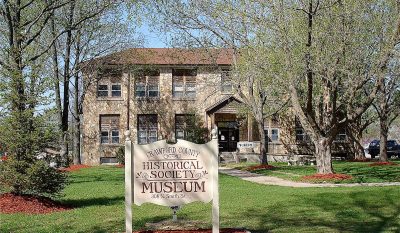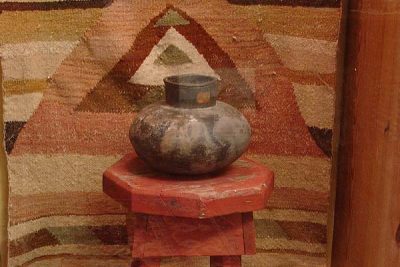The large 1934 two-story building at 308 N. Smith Street is imposing, but it all started with one cabinet and three items. Now there are three floors of history, and it overflows with items of historical interest.
 On Smith Street in Cuba, Missouri, next to Recklein Auditorium and across from the Recklein Library, a large, rock 1934 building sits back from the street with a green lawn in front. It even looks historical and is open to the public for a visit or for more extended tours and programs. It is the home of the Crawford County Historical Society and has a sign on the front entrance that reads History Museum in case there is any doubt.
On Smith Street in Cuba, Missouri, next to Recklein Auditorium and across from the Recklein Library, a large, rock 1934 building sits back from the street with a green lawn in front. It even looks historical and is open to the public for a visit or for more extended tours and programs. It is the home of the Crawford County Historical Society and has a sign on the front entrance that reads History Museum in case there is any doubt.
If you haven’t visited or taken your children to the museum, you are missing out on a real treasure. To take this step back in time is an enrichment that shouldn’t be missed.
As many stories do, it started once up on a time—with that one cabinet. Back in 1968, Elsie Norton felt that Crawford County should have a Historical Society. She and her friends Marie Martin and Nettie Snider drew up a list of people who they thought might be interested in joining. They held their first meeting at Recklein Library on February 29th. The minutes read, “This is an organization for all of Crawford County, who are interested in preserving the history.” Officers were elected at the first meeting. Members paid $1.00 dues.
One member, Mrs. Land of Leasburg, was also a member of the Missouri Historical Society, and she wrote to them for advice. The state society recommended a constitution, by-laws, and a board. Using these recommendations, the group became well organized with procedures to build on in the future.
During their first year, they added to their membership, conducted card parties, and served food at local auctions to raise funds for their projects. Members presented programs on their family’s history and papers on past Mayors of Cuba, such as Mr. William Mitchell, Mr. A.J. Barnett, Mr. J.M. Munro, and Mr. A.U. Farrar.
For their 5th meeting in June, members were asked to bring items for a show and tell. A program committee began to book speakers. James Cape donated a one-room school to the group for a preservation project. Letters with donations and memberships arrived from around the country as people became aware of the newly formed group. Requests for information about various Crawford County families began to arrive.
Their treasury grew from $25.60 in October of their first year to $209.30 in February of 1969. Unable to find another location, they continued to meet in the library. Optimistically, the group spent $3.09 at the Crawford Mirror for 100 membership cards. In June of 1968, Mr. Walter Rutz donated a cabinet for artifacts or records. With all the consideration it was given and all the moving around it experienced, it seemed as if the group knew its significance.
It was inspected by members and then taken to the Roberts-Judson woodshop for repairs where members who hadn’t seen it yet inspected it. Then the cabinet was moved back to Recklein Library for further consideration. It was decided that it would make a fine addition to the room. Roberts-Judson did not bill for the repairs, but the membership sent a thank-you note and a $10 check anyway.
 The cabinet was again moved to member Mrs. Forbes’ basement where members Mrs. Lloyd Engle and Mrs. Marie Martin re-finished it. It was returned to the Recklein Library where they received permission to keep it. According to the society’s September minutes, three unnamed items were placed in the cabinet. Thus began the seeds of the Crawford County Museum.
The cabinet was again moved to member Mrs. Forbes’ basement where members Mrs. Lloyd Engle and Mrs. Marie Martin re-finished it. It was returned to the Recklein Library where they received permission to keep it. According to the society’s September minutes, three unnamed items were placed in the cabinet. Thus began the seeds of the Crawford County Museum.
Over the years, the museum moved around and experienced the ebb and flow of members and interest, as does any organization. They eventually moved to one room in the rock 2 Score Plus building, which is their current building. Then seeking more room, they moved down the street to the old rock City Hall, which is now the Red Cross Center. Next, they moved back down the street to the former 2 Score Plus Building, which had originally been built as part of the Cuba Schools. Now they had the whole building and room to spread out.
Over the years, during all the moving, the organization continued to grow and add to its collections. More cabinets were added.
From these modest beginnings, Cuba now boasts its own History Museum with an advertised “Three Floors of History.” Not many small towns have their own museum.
When Historical Society President Betty De Leo is asked why these small museums are so important when there are much larger museums in St. Louis, she says, “ We preserve the history and culture of our community. We have local artifacts from our relatives and citizens of long ago that no one else would have as much interest in.”
Now the museum has well-organized exhibits on three floors with new artifacts being added. The collections are grouped together by theme in interesting arrangements. De Leo has had a lot to do with the arranging and rearranging until things look the way she wants them. Vice President Roger Tucker kids her about how often she moves things around. But he also appreciates her drive in making the museum a success through fundraising and promotion. “We could replace her, but we couldn’t fill her boots,” he says.
Some of the separate exhibits are the school room; the Native American area; the military room; the Bible displays; old school photos, yearbooks, and one-room school records; a parlor; a kitchen; quilts and wedding dresses; a bedroom; a children’s area; and artifacts from the railroad depot, including a conductor’s uniform and a telegraph; and farm implements. As the group advertises, it is three floors of history with items too numerous mention.
 The oldest piece in the museum is a 2000 year-old vase from the Dickinson Mounds, which was donated by George Brown from his father’s collection of Indian artifacts.
The oldest piece in the museum is a 2000 year-old vase from the Dickinson Mounds, which was donated by George Brown from his father’s collection of Indian artifacts.
On the second floor, there is a spacious area designated as the genealogy department. There are Crawford County tax records, from 1864, and census indexes from 1840-1880, as well as other written records. People visit here to research family histories.
Some of articles in the museum have been donated while others have been purchased to fill in the collections. They would like to upgrade the exhibits with wedding gowns and men’s formal clothes from 1890-1900. They would like more dishes in the 100-year-old range and early 1900s toys. Pictures from Cuba’s early years are desirable.
The museum encourages people to come in and sit and look at exhibits for a half hour or half a day depending on their time and interests. It is hoped that people will return after their first visit. Tours are also available to groups or individuals. Sometimes buses come to town to tour the murals and to visit the museum. The museum has hosted tours from family reunions, extension clubs, banks, and school groups.
One of the goals for the group is to involve schools in the museum more than they have been. The museum has all of the area schools and invited them to tour themuseum. Gary Durbin, one of Cuba’s history teachers brings his classes to visit every year. Other teachers have brought classes during the Christmas season to hear about the origin of Christmas customs and to make paper chains to place on the trees. But the museum staff would like to host even more student groups.
The staff of the museum is willing to work with any group to customize a tour or a presentation. If someone is looking for a specific photo or piece of information, they will also assist in finding what the person needs if they have it.
The city owns the building that houses the museum, and the Historical Society appreciates the city’s support. The whole area known as Recklein Commons was made possible by William Recklein and his wife. They bought the old Cuba School Complex when it was no longer used and then donated it to the city. Their vision made it possible to have the auditorium, the library, and the history museum in close proximity.
Donations provide the funds for the group’s work, so the support of the community is very important. Some funds from the Tourism Fund help to pay staff to keep the museum open on the weekends. Volunteers also staff the museum. With the number of exhibits a factor, the museum staff and volunteers do the cleaning. Admission to the museum is free although donations are appreciated. Tour groups are charged a fee.
Sometimes, the museum’s supporters are the very young. Once, after two young girls of 11 and 12 toured the museum, they returned with their brother and donated $2.37 in pennies and dimes.
The Crawford County Historical Society knows that the past is a treasure that must be preserved. But it also realizes that for the future of the museum younger members are needed to build on the museum’s strengths. Meetings are the third Wednesday of the month at 1:30, and visitors are always welcome.
